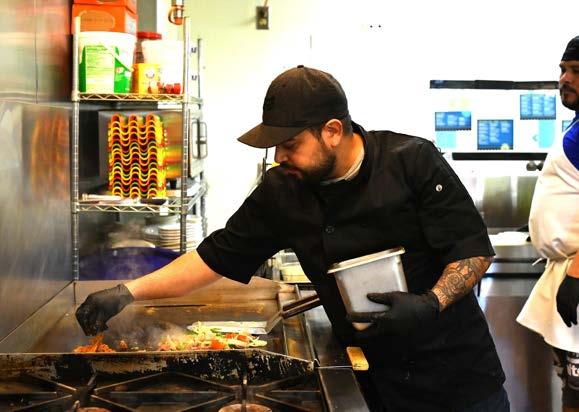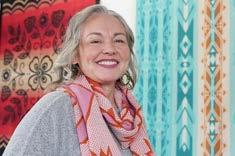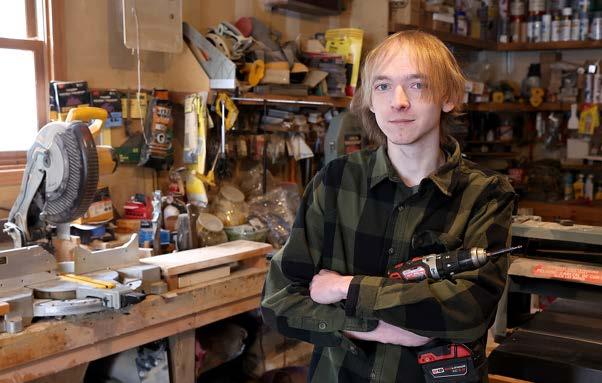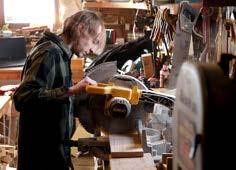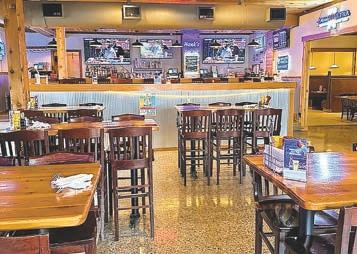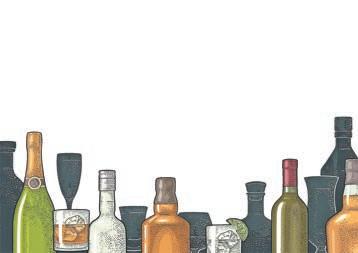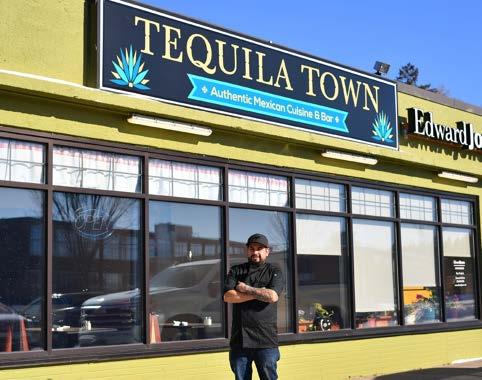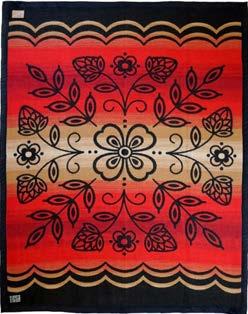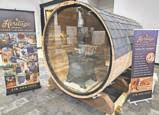New woodworking studio makes customized furniture
MACKLIN CARUSO Pine Journal
CLOQUET — Cody
Crisel learned much of what he knows about woodworking from his grandfather.
Dean Olson, a professional cabinet maker, would take Crisel along to contracting jobs when Crisel was 6 years old.
Today, Crisel is employing the skills his grandfather taught him as the owner of his own woodworking studio.
Labrador Woodworking — named after his dog — opened in Cloquet in January.
Crisel makes customized living room decor, including coffee tables, end tables and bookshelves, on a contract basis.
“I try to make it as custom and special as possible for the person’s home,” Crisel said.
The woodworker prides himself on the unique details of each piece of furniture he makes, such as intricate trim work or drawing attention to the grain of wood. Despite advances in technology designed to make furniture manufactured cheap for mass production, Crisel still prefers to make his customized hardwood furniture the way his grandfather taught him — with real wood.
“It’s hard to find nowadays real hardwood furniture,” Crisel said.
Crisel is an enthusiast of using solid hardwoods. He prefers to work with cherry, ash, walnut and maple. He gets his wood locally milled at the Lester River Sawmill outside of Duluth. Cheaper woods such as plywood are used only structurally and are never visible in his work, Crisel said.
By making his furniture with real hardwood,
Crisel believes he is making furniture that is both timeless and durable, which is becoming harder to find as corporate-made furniture is increasingly made out of manufactured wood and veneer.
“When you get veneered stuff, it chips, and someone spilling on it can warp that spot out and you’ll never get it looking good,” he said. By contrast, if something happens to solid-wood furniture, it only needs to be sanded and re-stained and it will look like it is brand new, he said. Before going into business, Crisel worked for his grandfather’s carpentry business, Olson Brothers. When Olson died in
March, he left Crisel his woodworking studio and equipment. Since opening, Crisel said the response to his work has been
CornerStone State Bank
The CornerStone of your Financial Future 1516 Cloquet Avenue • Cloquet, MN 55720 • 879-6781 Our commitment to you is to provide the best banking experience possible at very competitive prices, interest rates, technology, banking products, and services. Save, borrow, plan for retirement, buy a home, buy a business, buy a car, CORNERSTONE STATE BANK wants to be the Bank of your financial future. We appreciate your banking business, on-line or in person.
801 14th Street, Cloquet, MN 55720 • 218-879-7184 www.atkinsnorthlandfuneralhome.com Atkins would like Cloquet to welcome our new Funeral Director Ann Erdmann and Location Leader Michael Dilley
enthusiastic. He is booked out for the next two months. People interested in contracting with Labrador Woodworking are
encouraged to call or email to schedule an appointment. Crisel will then schedule a series inperson walk-throughs and video calls to get
Cody Crisel cuts a board that will be made into a stool at Labrador Woodworking in Cloquet on Feb. 5.
Cody Crisel runs a board through a planer.
Photos by Jed Carlson / Duluth Media Group
Cody Crisel, of Labrador Woodworking, stands in the same workshop where he honed his skills working alongside his grandfather in Cloquet on Feb. 5.
TEQUILA TOWN
He plans to get creative with agave wine — made from the same plant as tequila — and include it in margaritas and cocktails.
The liquor license should be on the Thompson Town Board agenda on Feb. 20 and the Carlton County Board agenda on Feb. 24, according to DeVriendt.
However, Mata decided not to wait for that license and opened on Feb. 12 selling food and non-alcoholic beverages.
“Everything is authentic. Everything is fresh,” Mata promises about the fare served in his new restaurant.
Mata and his business partners, Moises Morales and Fabian Morales, have been friends since they were children in Degollado, Mexico. The Morales brothers opened their first restaurant in Crystal in late 2023 and their second in St. Cloud in early 2024.
They invited Mata to join their business and run the third location. Mata had been working at a Mexican restaurant in Superior. His new role comes with added responsibilities, but he said he still prefers to be in the kitchen.
“I like cooking. I’m happy in the kitchen,” he said. From tamales to chorizo, most everything is made in-house and in
staying true to Mexican traditions, Mata said. Caleb Rhodes tried the burrito Degollado on his first visit to Tequilla Town on Feb. 13 and gave it a review of “phenomenal.” He didn’t have far to go for his first of likely many Tequilla Town orders. He owns the insurance agency next door and moved in not long after Mike’s Cafe and Pizzeria closed in May.
The space looks much different now with Mexican decor that Mata says is as authentic as the food. On one table, for example, is a stone statue of Maria that was handcarved by Mata’s father.
Large paintings on several walls were painted by Mata’s cousin and depict scenes from Degollado and the greater Mexican state of Jalisco.
One shows the harvesting of agave — the plant that will eventually expand the drink menu. Mata said a grand-opening celebration will be held after he has a liquor license At least for the nearterm, the restaurant is open for dine-in and takeout from 11 a.m. to 9 p.m. Sundays through Thursdays and 11 a.m. to 10 p.m. Fridays and Saturdays. As he shares his cuisine and culture with Esko, Mata said he has so far felt welcomed.
“People are helpful. There’s nice people in Esko,” he said.
Reporter Macklin Caruso contributed to this story.
Photos by Amy Arntson / Duluth Media Group
Rafael Mata, a co-owner and manager, stands outside the new Tequila Town restaurant in Esko on Thursday, Feb. 13.
Customer Caleb Rhodes puts in a to-go order at Tequila Town.
Tequila Town second chef Adrian Glez prepares lunch for customers on Thursday, Feb. 13.
Christoph believes that when designing a space, it is important to to not get swayed by trends, which inevitably go out of style. Instead, she prefers to incorporate older elements that have proven timeless, noting that the details of old buildings no longer exist in modern construction.
The building will retain many of the original brick walls, which will be featured in the apartments. To draw attention to the wall, Christoph will employ neutral colors to juxtapose high-contrast elements in the brick.
“The building is telling us to do this. The building really drives us,” she said. “It’s very important to tell its story.”
In cases where the builders are unable to keep original detailing, Christoph aims to replace it with similar design elements.
“We’re working on some just elements that would have been from the era,” she said. “It’s more modern, more durable, but looks like it could have been original to the building.”
The building was condemned, and then acquired by the city of Cloquet in 2022. Despite its historic value, the dilapidated condition of the building presented a dilemma for the city. Because of the high level of work required, the building would be unlikely to sell on the open market. However, demolishing the building would be expensive and leave a vacant lot in the heart of downtown.
Despite working on similar projects in the past, Scott and Jouppi were initially hesitant to take the project on due to the condition of the building, which at the time had severe structural problems, a flooded basement and failing roof.
The initial estimate to gut and rehabilitate the building was nearly $4 million. To mitigate some of the financial risk, the Cloquet Economic Development Authority — which has led the efforts to convert the old hotel into an apartment complex — provided C&C Holdings withcompetitive financing for the project. Scott said he is a history buff and was ultimately unable to pass up the opportunity to give new life to such a historic building.
“I would say me and Craig, we’ve never run away from a challenge,”
Scott said.
Scott estimates they are around 70% through with gutting the building. They have cleaned out the basement, abated hazardous waste and torn down the failing east wall of the building.
Just as the original hotel was built to house Cloquet’s workforce, Scott hopes that because of the apartment’s proximity to major employers like USG Interiors, Sappi and Community Memorial Hospital, the Solem Hotel will continue to provide housing for a new generation of Cloquet’s workforce.
“(It’s for) people working at their different facilities, maybe a nurse or somebody that’s working in the area looking for a place to stay,” Scott said. “We’re trying to bring some professional living space to the area.”
A major focus of Ojibwe art is functionality and how to make everyday items beautiful or tell a story, said Howes, a member of the Fond du Lac Band of Lake Superior Chippewa. At Heart Berry, Howes employs that framework to make Ojibwe art on a multitude of mediums, such as logos, clothing and blankets.
“I love to make things that people live with that’s like part of their life because that’s kind of how our art has always worked,” she said.
This is especially true in blankets, which Howes said historically served as a form of currency for the Ojibwe and are commonly given as a gift at major life events such as weddings or the birth of a child.
After partnering in 2014 with Eighth Generation, an art and lifestyle brand owned by the Snoqualmie Tribe in Washington state, Howes designed Heart Berry’s signature Renewal Wool Blanket.
She says the black and red tapestry conveys the interrelationships between the plants and animals that have historically sustained the Ojibwe. It features wild rice, dogwood flowers, muskrat prints and strawberries. In Ojibwe, strawberries are called “Ode’imin,” which translates to “heart berry.”
The blanket helps to visualize the Ojibwe value system, Howes said. As an example, Howes described wild rice as a gift that if harvested, not only makes you feel better because you are active but gives reason to care about the water it grows in.
“There’s this reminder that people put into our art, like these are these things that are these gifts that are there for you. This is like, ‘this good life that you have,’” she said. “These are all these amazing things that are there so we wouldn’t forget.”
Though Howes’ mother was a painter, she never really saw herself as much of an artist until she began participating in powwows.
When Howes started making beadwork and making moccasins, she noted that though there was a strong demand for cultural art, not many outlets provided it.
After receiving $800 in 2009 from Cobell v. Salazar, a class-action lawsuit over the mismanagement of Indigenous trust funds, Howes decided to use the money to start what would become Heart Berry.
“When I got the $800 I was like, people worked really hard for this, and so what would I want to do with this that would have meaning?” she said.
Heart Berry started on Howes’ kitchen table over a decade ago. As the business grew, it started to consume her home. Two years ago, she decided it was time to open a storefront in downtown Cloquet.
“I’m kind of winging it,” she said. “But I try to really wing it at a very measured, slow pace,” she said.
Brittany L Olson
Most of Heart Berry’s work is sold online and through Eighth Generation. Though most of her work sells in the Midwest, Howes has taken orders from as far as Finland.
While downtown Cloquet lacks foot traffic to sustain Heart Berry as a full-time retail shop, Howes also uses her storefront as a platform to teach classes as a means of cultural revitalization reconnecting people with cultural art.
As Heart Berry continues to grow, Howes hopes to expand wholesale operations as a means of institutionalizing Ojibwe art on a larger scale. She also hopes to start contracting with architecture firms to create massive Ojibwe art installations on the sides of buildings as a monument to her people.
“In that sense, our community sees it and knows that we’re beautiful and powerful,” she said. “But also other communities see that are like, wow, Ojibwe people are beautiful powerful, and so is their art.”
Contributed / Sarah Agaton Howes The Renewal blanket.


